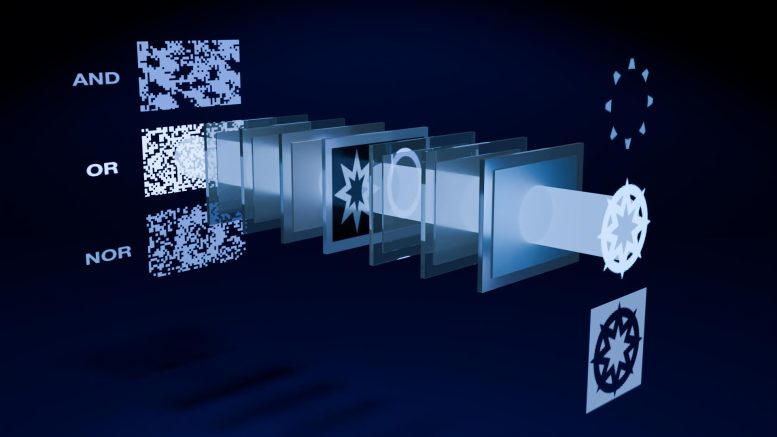
By University of Tokyo October 3, 2024
Collected at: https://scitechdaily.com/from-light-waves-to-logic-the-cutting-edge-of-optical-computing/
Researchers have developed a new architecture for optical computing called diffraction casting, offering power-efficient processing by using light waves.
This method promises better integration and flexibility for high-performance computing tasks and could be used in fields like AI and machine learning.
Optical Computing
As artificial intelligence and other complex applications demand ever more powerful and energy-intensive computers, optical computing emerges as a promising solution to enhance speed and power efficiency. However, its practical application has faced numerous challenges. A novel design architecture known as diffraction casting aims to overcome these issues, introducing innovative concepts that could advance the adoption of optical computing in future technologies.
The Limitations of Current Computing Technology
Whether it’s the smartphone in your pocket or the laptop on your desk, all current computer devices are based on electronic technology. But this has some inherent drawbacks; in particular, they necessarily generate a lot of heat, especially as they increase in performance. In addition, semiconductor fabrication technologies are approaching the fundamental limits of what is theoretically possible. As a result, researchers explore alternative ways to perform computation that can tackle these problems and ideally offer some new functionality or features too.
Advantages of Optical Computing
One possibility lies in an idea that has existed for several decades but has yet to break through and become commercially viable, and that’s in optical computing. Essentially, optical computing leverages the speed of light waves and their ability to interact in complex ways with different optical materials without generating any heat. Add to this the fact that a broad range of light waves can pass through materials simultaneously without affecting each other and you can in theory produce a massively parallel, high-speed, and power-efficient computer.
Introducing Diffraction Casting
“In the 1980s, researchers in Japan explored an optical computing method called shadow casting, which could perform some simple logical operations. However, their implementation was based on relatively bulky geometric optical forms, perhaps analogous to the vacuum tubes used in early digital computers. They worked in principle, but they lacked flexibility and ease of integration to make something useful,” said Associate Professor Ryoichi Horisaki from the Information Photonics Lab at the University of Tokyo.
“We introduce an optical computing scheme called diffraction casting which improves upon shadow casting. Shadow casting is based on light rays interacting with different geometries, whereas diffraction casting is based on properties of the light wave itself, which results in more spatially efficient, functionally flexible optical elements that are extensible in ways you’d expect and require for a universal computer. We ran numerical simulations which yielded very positive results, using small 16-by-16 pixel black-and-white images as inputs, smaller than icons on a smartphone screen.”
Potential Applications and Future of Diffraction Casting
Horisaki and his team propose an all-optical system, that is, one that only converts the final output to something electronic and digital; prior to that stage, every step of the system is optical. Their idea is to take an image as a source of data — which naturally suggests this system could be used for image processing, but other kinds of data, especially that used in machine learning systems, could also be represented graphically — and combine that source image with a series of other images representing stages in logic operations.
Think of it like layers in an image editing application such as Adobe Photoshop: You have an input layer — source image — which can have layers placed on top, that obscure, manipulate or transmit something from the layer beneath. The output — top layer — is essentially processed by the combination of these layers. In this case, these layers will have light passed through them casting an image (hence the “casting” in diffraction casting) on a sensor, which will then become digital data for storage or presentation to the user.
“Diffraction casting is just one building block in a hypothetical computer based around this principle and it might be best to think of it as an additional component rather than a full replacement of existing systems, akin to the way graphical processing units are specialized components for graphics, gaming, and machine learning workloads,” said lead author Ryosuke Mashiko.
“I anticipate it will take around 10 years to become commercially available, as much work has to be done on the physical implementation, which, although grounded in real work, has yet to be constructed. At present, we can demonstrate the usefulness of diffraction casting in performing the 16 basic logic operations at the heart of much information processing, but there’s also scope for extending our system into another upcoming area of computing that goes beyond the traditional, and that’s in quantum computing. Time will tell.”
Ryosuke Mashiko, Makoto Naruse, Ryoichi Horisaki. “Diffraction casting”, Advanced Photonics, DOI: 10.1117/1.AP.6.5.056005
This research was conducted as part of the Grant-in-Aid for Transformative Research Areas (A) project titled “Photonic Computing Highlighting Ultimate Nature of Light” led by Professor Tetsuya Kawanishi at the Faculty of Science and Engineering, Waseda University, Japan.

Leave a Reply